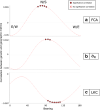High dispersal capacity of Culicoides obsoletus (Diptera: Ceratopogonidae), vector of bluetongue and Schmallenberg viruses, revealed by landscape genetic analyses
- PMID: 33536057
- PMCID: PMC7860033
- DOI: 10.1186/s13071-020-04522-3
High dispersal capacity of Culicoides obsoletus (Diptera: Ceratopogonidae), vector of bluetongue and Schmallenberg viruses, revealed by landscape genetic analyses
Abstract
Background: In the last two decades, recurrent epizootics of bluetongue virus and Schmallenberg virus have been reported in the western Palearctic region. These viruses affect domestic cattle, sheep, goats and wild ruminants and are transmitted by native hematophagous midges of the genus Culicoides (Diptera: Ceratopogonidae). Culicoides dispersal is known to be stratified, i.e. due to a combination of dispersal processes occurring actively at short distances and passively or semi-actively at long distances, allowing individuals to jump hundreds of kilometers.
Methods: Here, we aim to identify the environmental factors that promote or limit gene flow of Culicoides obsoletus, an abundant and widespread vector species in Europe, using an innovative framework integrating spatial, population genetics and statistical approaches. A total of 348 individuals were sampled in 46 sites in France and were genotyped using 13 newly designed microsatellite markers.
Results: We found low genetic differentiation and a weak population structure for C. obsoletus across the country. Using three complementary inter-individual genetic distances, we did not detect any significant isolation by distance, but did detect significant anisotropic isolation by distance on a north-south axis. We employed a multiple regression on distance matrices approach to investigate the correlation between genetic and environmental distances. Among all the environmental factors that were tested, only cattle density seems to have an impact on C. obsoletus gene flow.
Conclusions: The high dispersal capacity of C. obsoletus over land found in the present study calls for a re-evaluation of the impact of Culicoides on virus dispersal, and highlights the urgent need to better integrate molecular, spatial and statistical information to guide vector-borne disease control.
Keywords: Culicoides obsoletus; Dispersal; Landscape genetics; Microsatellite; Palearctic region.
Conflict of interest statement
The authors declare that they have no competing interests.
Figures



References
-
- Murray MD, Kirkland PD. Bluetongue and Douglas virus activity in New South Wales in 1989: further evidence for long-distance dispersal of the biting midge Culicoides brevitarsis. Aust Vet J. 1995;72:23. - PubMed
MeSH terms
Grants and funding
LinkOut - more resources
Full Text Sources
Other Literature Sources

